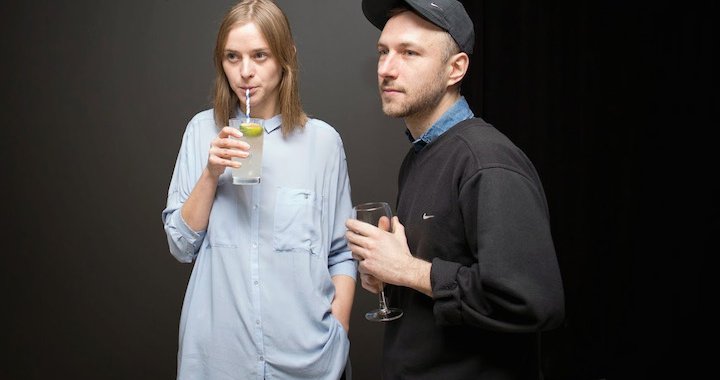
Interview with Ugnius Gelguda and Neringa Cerniauskaite (a.k.a. Pakui Hardware)
Jacquelyn Davis
20/02/2015
Pakui Hardware is the name (coined by Alex Ross) for the collaborative artist duo Ugnius Gelguda and Neringa Cerniauskaite which began in 2014, though the duo has worked together since 2012. As their site relays: The title Pakui Hardware refers to Pakui, special attendant of Haumea [Goddess of fertility whose children were born of various parts of her fragmented body] at Kailua, who could circle Oahu six times in a day. Thus Pakui Hardware is high-speed and brand politics as mythic semio-commodity as well as the desire to transcend the material limitations. Semio-Capital meets materiality. The duo is interested in the relationship between, technology, and economy. How technology is shaping current economy and the physical reality itself, including the human body. In relation to the velocity of technological development, the matter becomes both an obstacle and a vehicle. These questions are analyzed through such examples as High Frequency Trading, technological prosthesis and digital materiality. Through February 22, Pakui Hardware is exhibiting new work in their show titled “Lost Heritage” at kim? Contemporary Art Center in Riga and has previously exhibited at Jenifer Nails (Frankfurt), Contemporary Art Centre (CAC) (Vilnius), 321 Gallery (Brooklyn) and NADA New York. Both artists are based in Vilnius and New York City.
I would like to know more about how the two of you began as artists and then decided to join forces. What were each of your practices like when you began on your own, and how have they changed since working with one another?
We started collaborating in 2012 when we presented our first large project at Vilnius Contemporary Art Centre. Prior to that, Ugnius was mostly known as an artist working with audio-visual installations, meanwhile Neringa has worked as curator and art critic. Since our very first projects, we found it important to create specific situations in space, where the viewer would enter into particular experience—rather than just a show with several disparate objects. Later on, we continued working with this strategy but moved further from film to installations, objects, 3D motion graphics.
Many of your works revolve around the division between the real and fake. I'm thinking specifically of a previous work exhibited in Contemporary Art Centre (CAC) in Vilnius: “The Metaphysics of the Runner.” This work accentuated and deconstructed the aesthetics commonly associated with the athlete, runner and trainer expressed in today's media sources. You are interested in how technology shapes one's physical reality and the human body. Where does this interest originate?
It’s difficult to trace the origin of the interest—information flows continuously penetrate the mind. But the main influence derived from living in New York, where such athletic aesthetics are almost an imperative and are adopted and explored by a number of artists. Next to the visual/aesthetic influence, we researched ideas like transhumanism, digitalized subjects, accelerationism and synthetic biology. Already then, we distinguished specific traits that seemed to connect these distinct ideas, such as the relationship between virtual or abstract (such as algorithms or human mind) and material—body, hardware, matter, energy. The aforementioned philosophies and notions provoke to reconsider what is the human itself and what is its position in the environment: is it a privileged one? What should be preserved in the human? Who makes such decisions? How can technologies allow us to radically redesign ourselves and nature? Such questions trouble fundamental concepts of what is “natural” and where lies the “equilibrium” between what’s given and what’s created/man-made.
After “The Metaphysics of the Runner,” we explored these ideas through different angles and phenomenon such as “High Frequency Trading” and synthetic biology. However, in all of our projects, we test the real vs. the fake or the real vs. more real—in a sense that we attempt to create a specific twist where this distinction is troubled. By employing familiar objects, interiors or design, we create a sort of estrangement effect—creating an uncanny feeling and invoking a sense of artificiality.
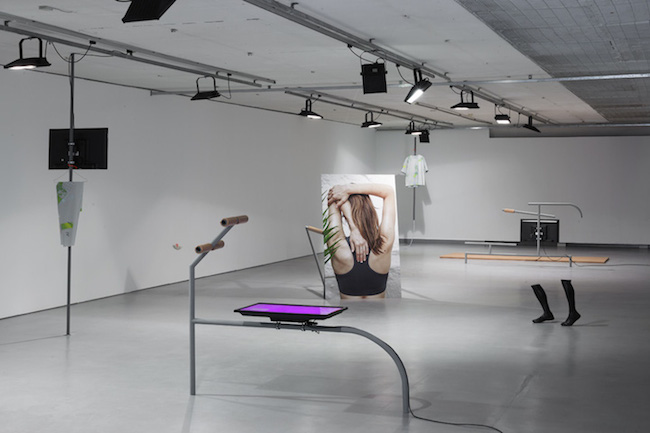
Pakui Hardware, The Metaphysics of the Runner, 2014. Exhibition view, Contemporary Art Centre (CAC), Vilnius, 2014
What is your relationship with and to the design world? Your exhibition experiences are deliberate and well-orchestrated, which makes me wonder: how much visual and technical design components are purposefully part of the final exhibition, or rather: is the final exhibition is displayed more spontaneously and less premeditated?
When we work on solo shows, each time the installation design is determined by the specificity of the space itself. For example, the long, narrow and low space at Vilnius Contemporary Art Centre provoked the idea of the installation as a sort of a gym, while the former commercial space in Frankfurt—Jenifer Nails—invited us to make something related to trading or office, so it ended up being a post-office or office-no-longer with some design elements that refer to the design of the Frankfurt’s main trading floor. We deliberately combine and mix ready-made and crafted objects in order to create these kind of uncanny or sometimes even irritating situations, where familiar objects and space seem mute and sometimes a little hostile.
Perhaps it’s worth mentioning that we’re interested in design in a more abstract sense—as a central concept and strategy today and in the future, because it incorporates ideas (projects), control and aesthetics. For example, synthetic biology uses the term “designing” when speaking about the future ways of creating synthetic organisms in other words—nature.

Pakui Hardware, Shapeshifter, Heartbreaker, 2014. Exhibition view, Jenifer Nails, Frankfurt, 2014
The internet is now a necessary ingredient in most peoples' lives; your artist duo highlights the individual's situation which oftentimes revolves around alienation and detachment. We are all affected by our interactions and presence on the web, but we are in charge of how much we are involved with these spheres of information. Many consider you to be 'post-internet artists.' What are your feelings about being labeled as such, and what label do you give yourself?
Labeling is usually made for the convenience of an institution, curators and art critics, unless it is made deliberately by artists or their collectives in a manifesto kind-of-way. For us, as for the majority of artists who are labeled, the notion of 'post-internet' is too narrow as it incorporates mainly the internet and what is related to it. As our field of interest and practice encircles more about the relationship between technologies (and all that comes with that—virtuality, velocity, circulation, etc.) and materiality (i.e., body, hardware, matter, energy), the post-internet label is reductive. Some artists prefer to be called ‘accelerationists,’ but that’s too ambitious. Perhaps, the term ‘post-digital’ could be more appropriate as it encompasses the relationship of everything that has been or will be digitalized (including the brain functioning, for example) and its integration into the matter. But Pakui Hardware is the label we already carry and do it with joy.
Tell me about your most successful versus your most unsuccessful (or “failed”) collaboration experience. Have you learned lessons, or have the two of you developed tricks to be more focused or productive when making work? Have any of your works resonated as being most smooth or glitch-free in comparison to others—if so, why do you think that this was the case?
When it is 4 a.m., and the opening is in three days, and you are in your studio polishing one work that still doesn’t seem right—it is during such moments that the collaboration experience gets cloudy—really cloudy. But as such moments come only with larger solo presentations, they don’t affect the overall experience too strongly. However, there is another side of production that could not be considered as a collaboration, and that is working with manufacturers or specialists of specific fields. In such cases, you are dependent on someone else's schedule, mood and sense of responsibility. This side brings “surprises” and kills brain cells. As we usually create installations that encompass a number of different elements, we are forced to learn variety of new things every time—including gardening, for example.
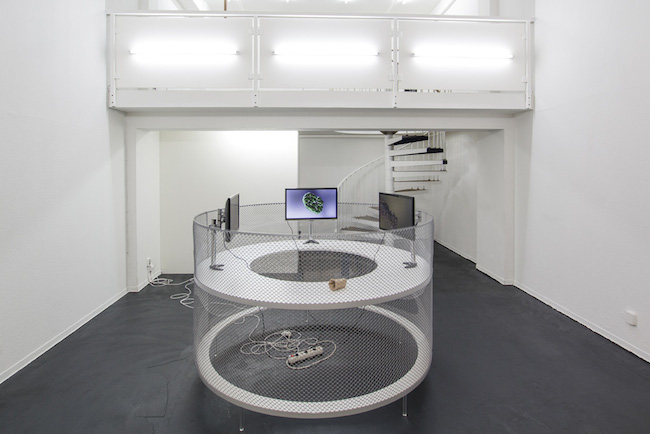
Pakui Hardware, Shapeshifter, Heartbreaker, 2014. Exhibition view, Jenifer Nails, Frankfurt, 2014
What other contemporary artists do you feel have influenced your practice, and why?
An artist list would take up too much space in this conversation; we admire a number of them! It’s easier to name galleries and institutions that have gathered artists with similar practices and ideas—that promote and support their art in intelligent ways, including galleries and artist-run spaces such as 47 canal (NY), Tomorrow (NY), Jenifer Nails (Frankfurt), Future Gallery (Berlin), Grand Century (NY), Kraupa-Tuskany (Berlin), Toves (Copenhagen), New Galerie (Paris/New York) or initiatives like Minibar Artist Space (Stockholm), Siliqoon (IT), DIS art collective (NY)—or institutions like Yale Union (Portland) or Sculpture Center (NY).
You are both Lithuanian. How do you feel about the Lithuanian art scene—in comparison to other Baltic regions, as well as other parts of Europe and abroad? What do you think should happen (or not) so that the Baltic art scene improves in the future?
The Lithuanian art scene, just like any other small scene, has a tendency to turn things into hegemony. It is difficult to speak of several scenes then, when only one is dominating, because the work of other initiatives is in or is always considered to be in relation to the dominating scene/institution/artist group. But it is mainly the number of people which is to blame—the scene is just too small with too few 'players' to be more dynamic and have several equally strong scenes, as is the case in megapolises such as London or New York. Thus, art communities in the Baltics are tight—too tight sometimes. Therefore, it seems crucial for young local artists to acquire education outside of the country—to gain perspective locally and internationally.
Lithuania is lucky, as it has several strong institutions promoting artists both locally and internationally, but there should be stronger Lithuanian representation abroad. That is one advantage of the Swedish art scene; it offers generous opportunities for artists to participate in the international art world.
Regarding your project at kim? titled “Lost Heritage,” how did the idea for this project arise? Are you content with the results of this exhibition? Did the actual presentation of the exhibition line up with your initial idea? When viewing show images, the installation presents dysfunctional factors in a synthetic garden—components deliberately not serving their intended purpose. For instance, a fire hydrant does not face the grass it is expected to water. The fake is presented as real; there is discomfort located in one's attempt to understand how LED lamps can provide energy for each false green blade and dripping faux-organisms. Also, tell me more about how this installation is linked to Prometheanism and Ray Brassier.
“Lost Heritage” quite “naturally” evolved from continuing our research into digital organisms and then moving towards synthetic organisms and synthetic biology. While in “Shapeshifter, Heartbreaker” which we presented at Jenifer Nails, we explored ecology of algorithms, their interactions and relationship to human; in “Lost Heritage,” we materialized our thinking and imagination about ideas of synthetic biologists and their attempts to create organisms from scratch. Their project, in our view, is closely related to Ray Brassier’s ideas around Prometheanism, where he questions the dogmatic understanding of the “natural” equilibrium between what is given (e.g., death, disease) and what is man-made. He calls this acceptance of the notion of equilibrium irrational and provokes one to reconsider the notion. We were interested in what forms this destruction of equilibrium could take—or how far it can be pushed.
It’s important to note that the title “Lost Heritage” is ironic: we are not trying to mourn over something lost, but rather: we are reconsidering what embodies “heritage” in the first place. The installation balances between lightness and, again, a sense of uncanny. It, as you have mentioned, works as a dysfunctional garden-laboratory—emphasizing its artificial nature.
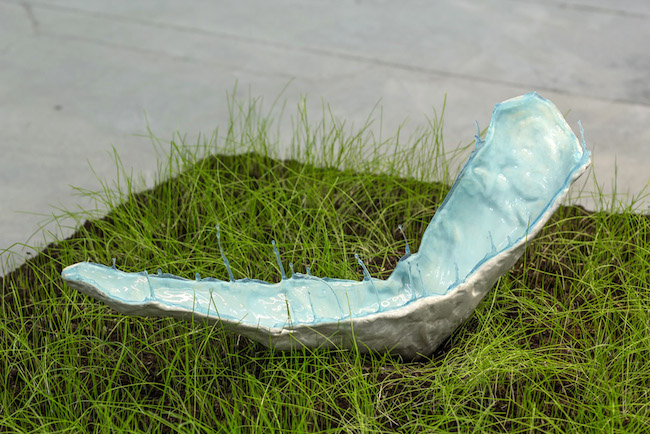
Pakui Hardware, Lost Heritage, 2015. Exhibition view, kim? Contemporary Art Center, Riga, 2015
Do you consider yourselves futurists? Have you considered your art to be in close connection to ideas such as transhumanism? What is your perspective on your role as artists in our present era, and how do you predict your art will evolve?
We wouldn’t call ourselves futurists—more so realists who enjoy speculating on the future. It’s the only way to deal with our swiftly changing environment. We are not alone here, of course; with the rapid development of technologies and science, the world seems to be on the verge of fundamental changes. This sense and understanding provokes cultural workers to reflect on this condition. For example, a series of talks and events organized by Triple Canopy at MoMa PS1 in 2013 called Speculations (“The future is ______”) invited artists, writers, scientists and interdisciplinary practitioners to present their visions of the future. It is of great importance to put theoretical and ethical fundaments for the future—before it arrives. As for our own future practice, it’s not easy to say what exact form it will take, but it continues to explore the merging of two realities: virtual and physical—and the relationship between them.
With many artists today, their work is neither obviously nor consciously socio-political. What is your political stance, if you have one (or a few), regarding interconnected spheres of politics versus art? Can you give examples in your work of where you were deliberately being political to make a point or draw attention to an issue?
We have never been very fond of working politically; it’s easy to slip into being mere representations of politics—or to become political instead of artistic. There is a fine line between the two, and only a few artists know how to walk on it. Until recently, political theories and movements could not offer sufficient horizons or strategies, especially considering the deep crisis of the Left. However, it is interesting to explore and observe the development of the so-called accelerationism and their new, more productive, position in relation to capitalism. Instead of being disempowered, they urge to take over capitalist infrastructures and strategies and to make changes (and finally destroy capitalism) on a global scale. Thus, technology is seen as an empowering tool. Although not openly, our last two projects—“Shapeshifter, Heartbreaker” and “Lost Heritage”— refer to these ideas and strategies.
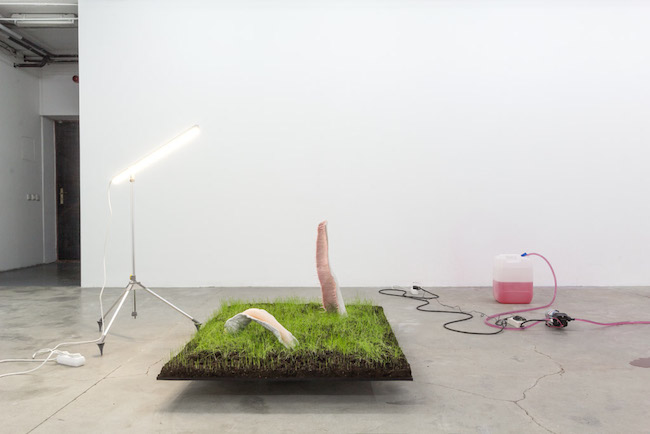
Pakui Hardware, Lost Heritage, 2015. Exhibition view, kim? Contemporary Art Center, Riga, 2015
You have participated in multiple international exhibitions and residencies—I'm now thinking of Sweden. How do you find the environment for producing art in Scandinavia in comparison to the Baltic region? Describe projects that you have followed through with in Scandinavia?
We still have a superficial understanding of the actual situation for Scandinavian artists, yet it seems that their financial conditions are better in comparison to their fellows in the Baltic states. Like almost everywhere else in the world, artists must have day jobs to sustain themselves, yet Scandinavian salaries allow one to pursue their craft with less effort. It’s clear that wherever the art scene is, it highly depends upon the self-organization of artists; if artists aren’t satisfied with activities and strategies of their local institutions, they should change the situation by creating alternatives rather than complaining. It is natural for Scandinavian artists to be disappointed by weakening socialist positions and ideals and the harsh inequalities brought by the neoliberal regime; it’s sad to watch how positive situations are dismantled so easily.
During our residency, we worked on upcoming projects in Frankfurt and Riga—and on three performative lectures which occurred in Stockholm and Malmö. During our free time, we enjoyed extensive conversations with local artists and curators.
What themes do you enjoy working with, and how do you approach working with these themes (if indeed one theme requires a distinct approach)? What do you most like and dislike about being an artist? What have you imagined yourself to be if you were not one?
Let’s start from the positive side: the luxury of exploring ideas, objects and materials that we are interested in; the luxury of having one's own schedule; the luxury of not having a permanent address; the excitement of constantly meeting interesting people; an inexplicable sense of community with artists that you've met only virtually. The downside is the same as it is for every cultural worker: precariousness. What would we be if we weren’t artists? Long distance runners, probably.
When thinking of the words 'art' or 'artist,' do have a specific definition or set of requirements for each lexicon, either individually or together as a duo?
When working almost anonymously for a brand which is a courtesy of a “third party,” artists become more so employees in the art world—producing works and status for the “company.” Of course, the courtesy is more of a play with rules of commerce in the art world, but it allows for some detachment which is interesting to approach. Even on our facebook profiles, one will find “Pakui Hardware” under our “employers” category.
If you could follow through with a creative project or work without being impeded by real-life factors such as politics, money, time or criticism, what would this project be—how do you imagine it would unfold?
It would be a life-long project and would involve creating an autonomous reality within reality—a reality so integrated into the “real” one that it would become more real than real. Similar to the story of Synecdoche, New York—or like the man who calls himself Kurt J. Mac who tries to reach the edge of the universe in the game Minecraft, walking virtual miles accompanied by a wolf each day. Like his walk, the creation of another form of reality would be about “the journey—not the destination.”
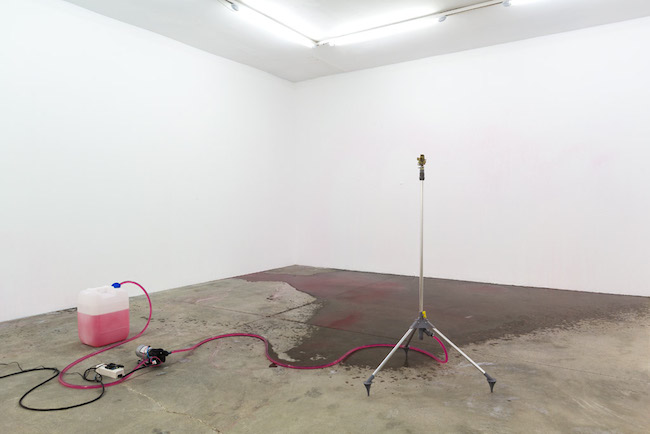
Pakui Hardware, Lost Heritage, 2015. Exhibition view, kim? Contemporary Art Center, Riga, 2015
What new projects or plans do you have lined up this year?
We’re currently working on a commissioned project for the Berlin-based contemporary art magazine KubaParis for which we will create a small-scale virtual exhibition in a vast physical space, as we are on a residency at Nida Art Colony. Results of this project will be published in the magazine. Also, there are group exhibitions in Europe coming up, but mostly, we would like to continue researching and working on the “Lost Heritage” theme.